AWS SAA-CO2 Serverless
Basics
Lambda is compute service to run code as functions. Don't need to set up infrastructure
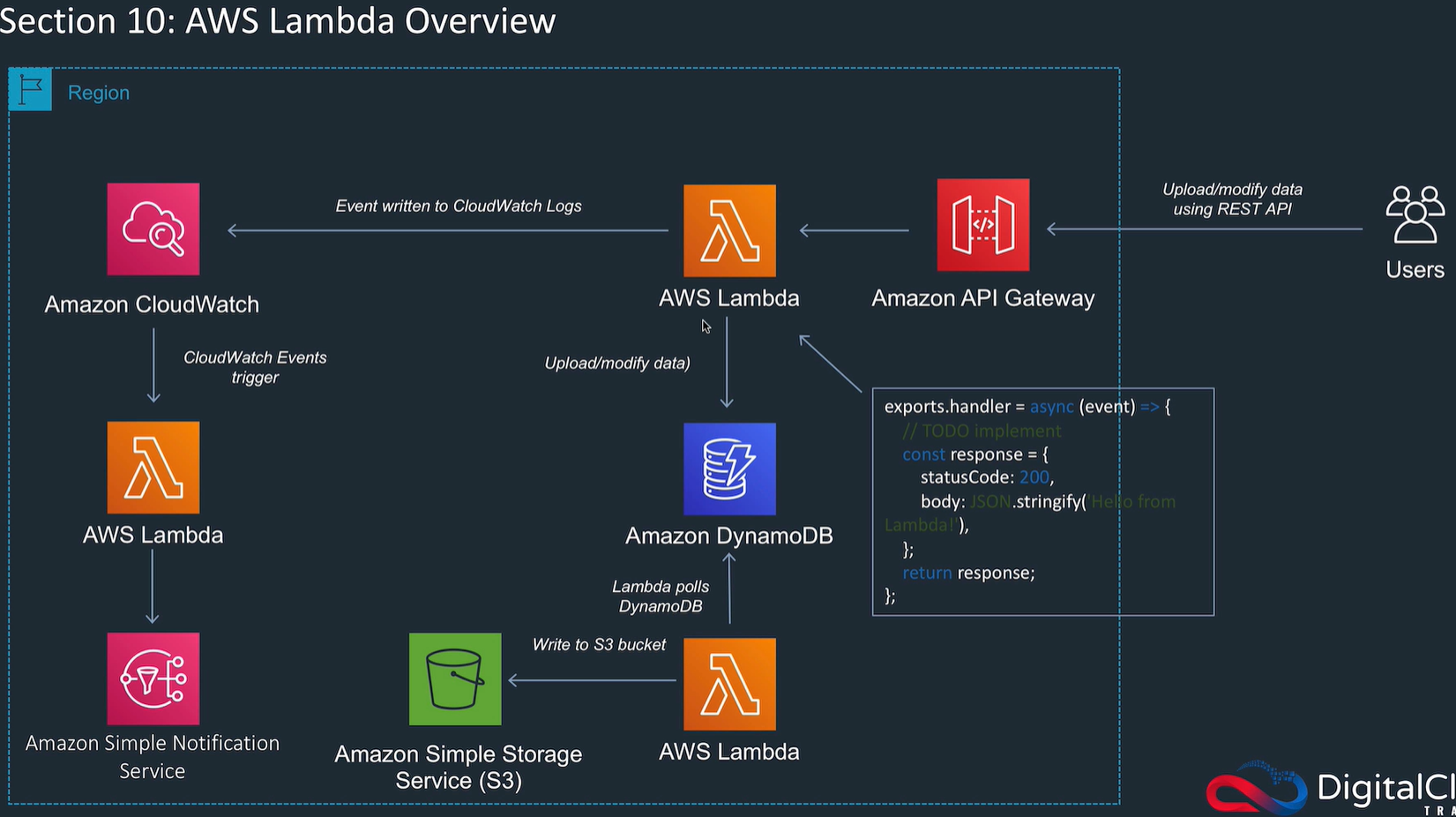
Lambda doc site
- Invoke to respond to events (S3, SQS, DynamoDB), requests from API Gateway, AWS SDK calls from client.
- AWS manages compute float to balance memory and CPU etc.
- You can't see into compute, or customise the runtime.
- Edit code on console, deploy with .zip. or deploy container.
Terms
- Functions: basic unit
- Qualifier: version and alias for a function, e.g. func:1, func: BLUE
- Layer: .zip archive with libraries, other dependencies. Share between functions. Don't use with containers.
- Runtime: language specific environment.
- Extensions: custom tool integration, separate process invoked first, runs in parallel.
- Event: the JSON input data for the function
- Concurrency: number of processes running at one time to run process requests to your function.
- Trigger: a resource that invokes a lambda function.
- Event source is an AWS service or developed app which produces events which trigger a Lambda function.
- Event source mapping: resource in Lambda that reads items from a queue and invokes lambda function.
- Initialisation: first time a function loads to memory. Then stays available. Runs code to setup. Pay for time spent initialising.
Concepts
- Scales by running additional instances
- Instance when alive can run one invocation, then waits for next.
- Use local storage in /tmp
- Store state in other services, don't rely on instances being long lived.
- Use class level object to increase performance
- event sources maintain the mapping (e.g. S3), except for stream based services where the config is on the Lambda side and Lambda does polling (.e.g. Kenesis, DynamoDB)
Concurrency
Set a concurrency limit. Default quota of 1000 concurrent for a region for an account
Set reserved concurrency for each function to limit the amount of your account concurrency each function can take

Use provisioned concurrency where initialisation is expensive or low latency required.
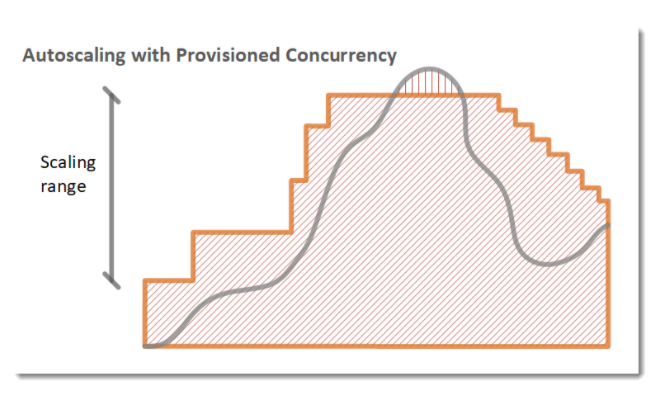
Invocation types
Synchronous: wait for the function response before continuing
Asynchronous: queue event for function, return immediate response. Lambda handles retries, configure this or use failed queue.
Event source queue: Batch invocation, sends multiple events from e.g. DynamoDB queue to Lambda as batch.
Languages
- Node JS
- .NET C#
- Java 8
- Python
- Ruby
- Go
- Powershell
Limits on memory size, layers, payload size, storage etc.
setup
Choose an IAM role
Events: Lambda polls, or services poll lambda
Set memory, allocates CPU proportionately
Set timeout 3s to 15 mins.
If go high memory then goes multi thread
Concurrency: default limit 1000 per account, limit per function
Billed for the duration and memory.
Logs: start, end, report
Use cases
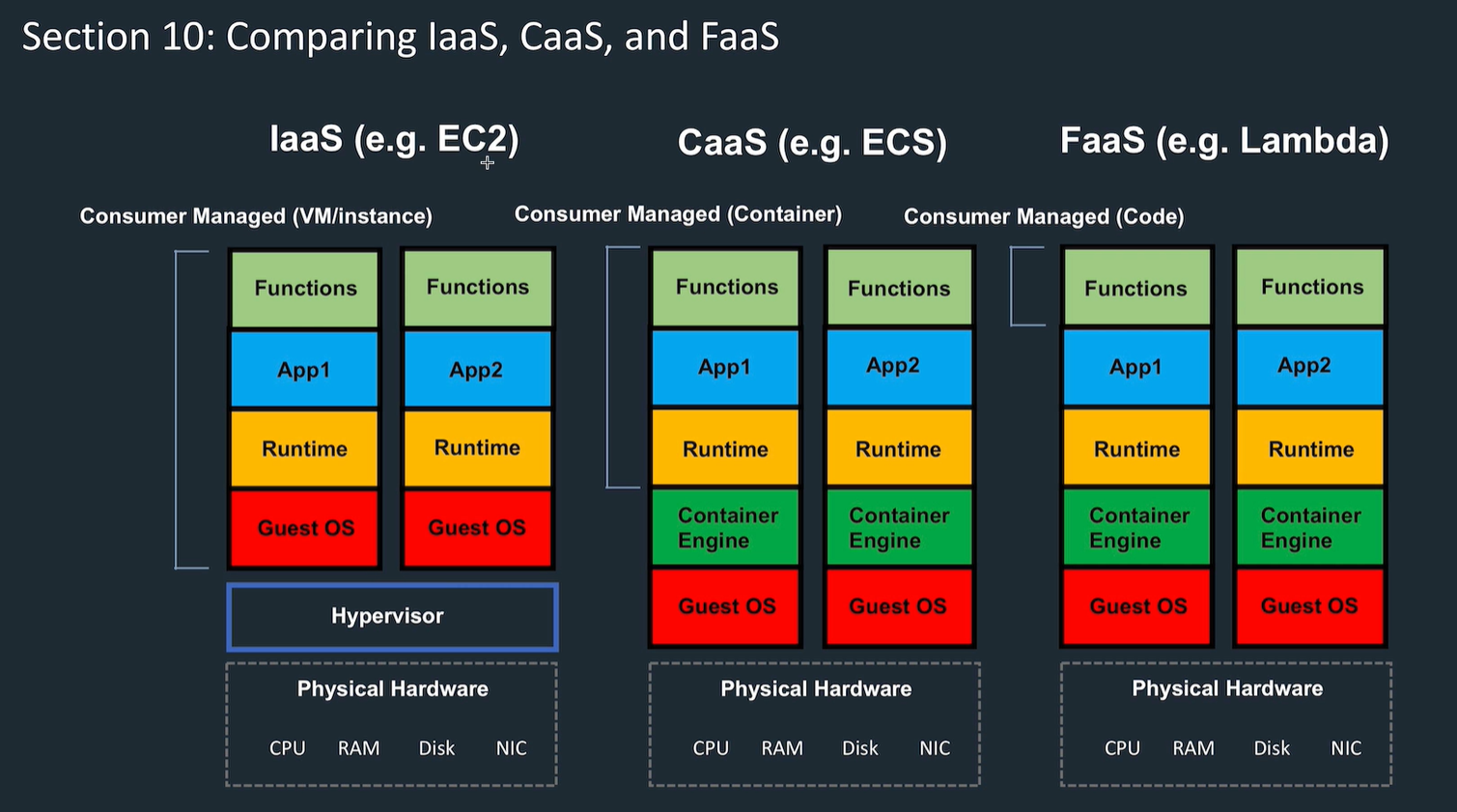
- Iaas - EC2
- Caas - containers (ECS)
- FaaS - lambda
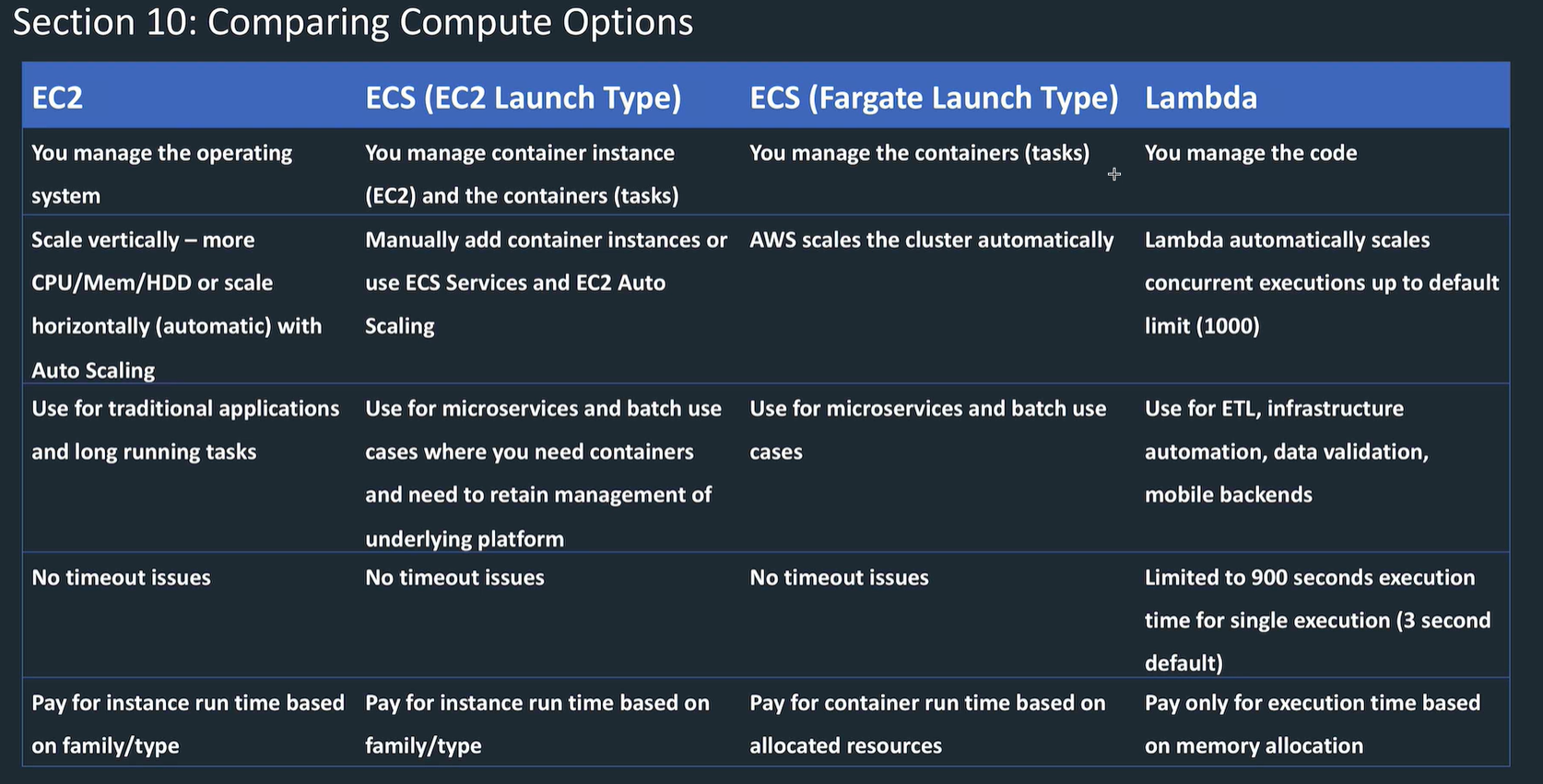
EC2 good for custom code or big packages
Vendor packages gradually moving to containers.
Lambda good for custom code.
EC2 scaling
Horizontal scaling: more machines
Vertical scaling: more CPU / mem / disk
Notifications
Push notifications
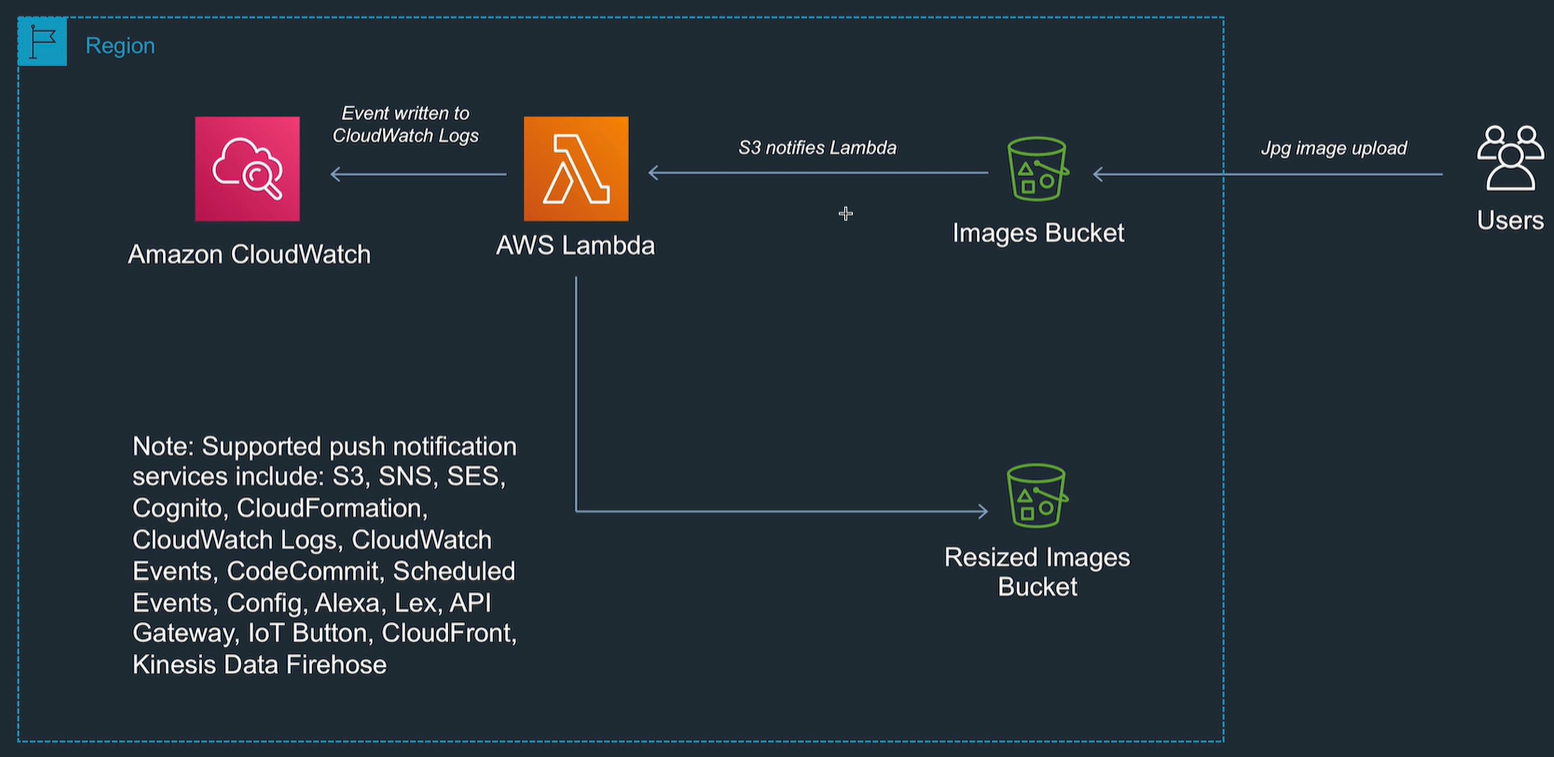
Pull based
Lambda does the polling of the other services (actually e.g. Dynamo DB)
Example Lambda app image resize
aws lambda create-function --function-name CreateThumbnail --zip-file fileb://function.zip --handler index.handler --runtime nodejs12.x --timeout 10 --memory-size 1024 --role arn:aws:iam::205850140633:role/jb-lambda-S3-role
--cli-binary-format raw-in-base64-out \
aws lambda invoke
--function-name CreateThumbnail
--invocation-type Event
--payload file://inputFile.txt
--cli-binary-format raw-in-base64-out
outputfile.txt
Lambda steps
- Set up policy to read write to S3 and logs
- Set up role
- attach the policy
- set up trust relationship so lambda service can assume the role
- package the software to a zip file
- aws Lambda create-function to upload a function, give the function rights to assume the role
- aws Lambda invoke to run
- aws lambda create-event-source-mapping: create the polling event.
- look at the logs
Layers contain the libraries, custom runtime, dependencies you need to run the code
Function display show the resources it has access to.
Use AWS server application model (SAM) to deploy and manage Lambda functions.
Automate release process using AWS codePipeline and AWS CodeDeploy
AWS x-ray for lambda tracing.
API Gateway
- AWS service for creating, publishing, maintaining, securing REST and websocket apis at any scale.
- HTTP based, stateless client server comms via TEST, implement standard HTTP methods GET, POST, PUT, PATCH, DELETE.
- Scales for any number of API calls.
- Pay based on number of calls and volume of data transferred out.
- Only HTTPS
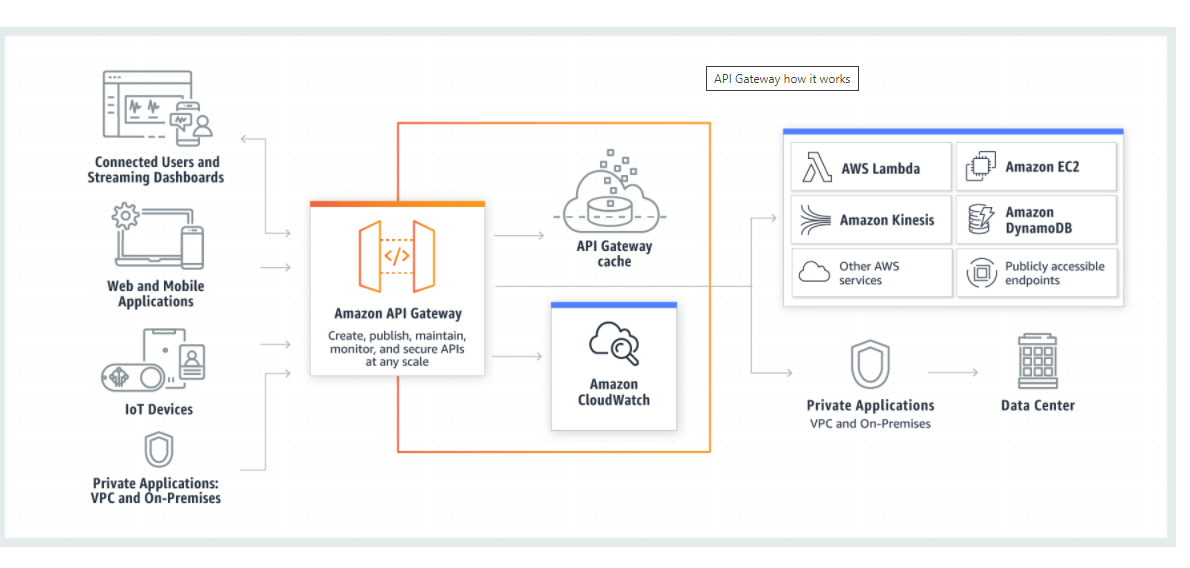
- Handles multiple versions
- Monitor in cloudwatch (or cloudtrail)
- Uses edge locations on cloudfront
- Optionally set to require authorisation.
- Can use AWS signature version 4 (access and secret keys) or Lambda Authorisers (use a bearer token e.g. OAuth) and return IAM policies which are used to authorise the request.
- costs decrease as scale goes up
- Route requests to private resources in your VPC behind private ALBs.
- Set throttling rules based on calls per second to each method.
- API endpoint types can be edge, regional, or private.
Websocket
Real time 2 way comms e.g. chat apps, streaming dashboards. Persistent connection between client and server.
RESTful APIs
- HTTP API: simpler, cheaper, good where only need API proxy functions (ie call Lambda or other endpoint with parameters). Basically just a pass through to the HTTP call on the ALB / Lambda.
- REST API: If need API proxy and API management features, use REST api. REST method is a resource and a method, e.g. /income & POST could mean add info to the users income. The integration requests is what the API Gateway sends to other resources, e.g. pass to DynamoDB with action, role, policies, transformation. Integration response back to API Gateway, then responds to client.
example dynamo db & lambda application
Stream based services: Dynamo FB, Kenesis, SQS: lambda need to poll these services, not respond to events from them.
Look at the dynamo db example







